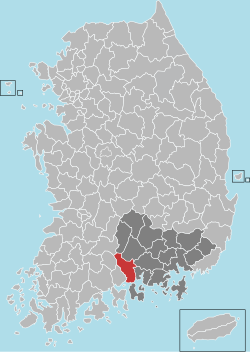Hadong County
Hadong
하동군 | |
|---|---|
County | |
| Korean transcription(s) | |
| • Hangul | 하동군 |
| • Hanja | 河東郡 |
| • Revised Romanization | Hadong-gun |
| • McCune-Reischauer | Hadong-kun |
 Flag  Emblem of Hadong | |
 Location in South Korea | |
| Country | |
| Region | Yeongnam |
| Administrative divisions | 1 eup, 12 myeon |
| Area | |
| • Total | 675.53 km2 (260.82 sq mi) |
| Population (2003) | |
| • Total | 58,010 |
| • Density | 85.9/km2 (222/sq mi) |
| • Dialect | Gyeongsang |
Hadong County (Hadong-gun) is county in South Gyeongsang Province, South Korea. It is on the far west side of the Province, and borders South Jeolla Province. The County office is located at Hadeong-eup.
History[]
The county of Hadong was called 'Dasachon' (county of much sand) when it was a part of the Jin state; later becoming a part of 'Nangnoguk', one of 12 statelets of the Byeonhan confederacy. According to the History of the Three Kingdoms, it was called Handasa-gun and was changed into 'Hadong-gun' in 757 during the reign of King Gyeongdeok. In the Goryeo Dynasty, it was known as Hadong-hyeon. In 1414, during the reign of the Joseon Dynasty King Taejong, it became 'Hanamhyeon' with 'Namhaehyeon'. It was raised to the status of 'Hadongdohobu' in 1740, in the 30th year of King Sukjong's reign.[1] During the Korean War the region was the site of a North Korean attack on US Army forces, the Hadong Ambush.
- 1702: Ackyang-hyeon added to Hadong-gun
- April 1, 1914: Seo-myeon and Geumyang-myeon, Gonyang-gun added.
- January 1, 1915: Part of Seomjin-ri, Daap-myeon, Gwangyang-gun, Jeolla South Province added to Hadong-gun.
- 1916: Naehoengbo-myeon renamed to Choengcheon-myeon.
- 1918: Dong-myeon renamed to .
- 1933: Deokyang-myeon renamed to Hadong-myeon.
- October 1, 1938: Hadong-myeon elevated to Hadong-eup.
Local sights and attractions[]
Nestled between the Seomjin River and Mount Jiri, the county is a popular destination for both domestic and foreign tourists who enjoy nature.[2] Parts of the Jirisan National Park lie within the county and form the county's notable hilly, mountainous landscape.[3]
The Ssangye Temple is a notable historic temple of the Jogye Order of Korean Buddhism and is a designated National Treasure.
Pak Kyongni's 16-volume novel Land is partly set in the village of Pyeongsa-ri in Agyang-myeon, Hadong County. A replica of the fictional Choi family's home was built there to commemorate the author's legacy.[2][4]
Green tea[]
Hadong has been famous for its green tea since the Silla era when an envoy returned from the Tang Empire with green tea seeds and planted them on local soil.[2] The local government has been promoting this as a major local attraction and sponsored a tourism advertisement that aired on CNN in 2007.[5] The local "wild tea" festival lasting 25 days takes place annually during May and June.[2][3]
Development[]
While much of Korea has experienced an explosion of industrial development, Hadong remains a destination for those who wish to escape the bustle of city living.[original research?] However, a lack of activity in the industrial sector has left the government with little incentive to expanding the sometimes inadequate existing road infrastructure.[original research?] A petition for the allocation of funds for new road construction was signed by a number of Hadong residents.[6]
South Korean president Lee Myeong bak has recently[when?] announced plans for the construction of a Gyeongsangnam-do leisure resort palace in Hadong.[7]
Notable people[]
- Jeong Ki-ryong
- Lee Byeong-ju
- Jeong Ho-seung
- Kang Man-soo
- Jeong Gong-chae, the notable Korean poet
Schools[]
- High schools
-
- Middle schools
- Agyang Middle School
Twin towns – sister cities[]
Hadong is twinned with:
 Anyang, South Korea
Anyang, South Korea Gwangyang, South Korea
Gwangyang, South Korea Geoje, South Korea
Geoje, South Korea Seongdong-gu, South Korea
Seongdong-gu, South Korea Haeundae-gu, South Korea
Haeundae-gu, South Korea Zhangqiu, China
Zhangqiu, China Ya'an, China
Ya'an, China Zhangjiajie, China
Zhangjiajie, China
See also[]
- List of Korea-related topics
References[]
- ^ Official website http://www.hadong.go.kr/e/main/frame.asp?test=/e/01/01_02.asp?m=m1 Archived 2016-03-04 at the Wayback Machine
- ^ Jump up to: a b c d "Green Tea, Nature and Market at Hadong". The Korea Times. 2008-03-13.
- ^ Jump up to: a b "Asia Society Korea Travel Series 4 – Hadong County". Asia Society. Retrieved 2021-03-05.
- ^ "A statue of Pak Kyong-ni to be set up at Toji Foundation". The Dong-a Ilbo. 2018-05-03.
- ^ http://www.hadong.go.kr/e/main/frame.asp?test=/e/01/01_02.asp?m=m1[permanent dead link]
- ^ 하동군 국도 19호선 4차선 확.포장 시급 Newsis 2008-01-22
- ^ [이명박 정부 개발 핫 이슈] "동아시아 7대 경제권 도약 꿈꾼다" 2008-01-22 Retrieved 2008-01-26
External links[]
| Wikimedia Commons has media related to Hadong. |
- Hadong County
- Counties of South Gyeongsang Province

